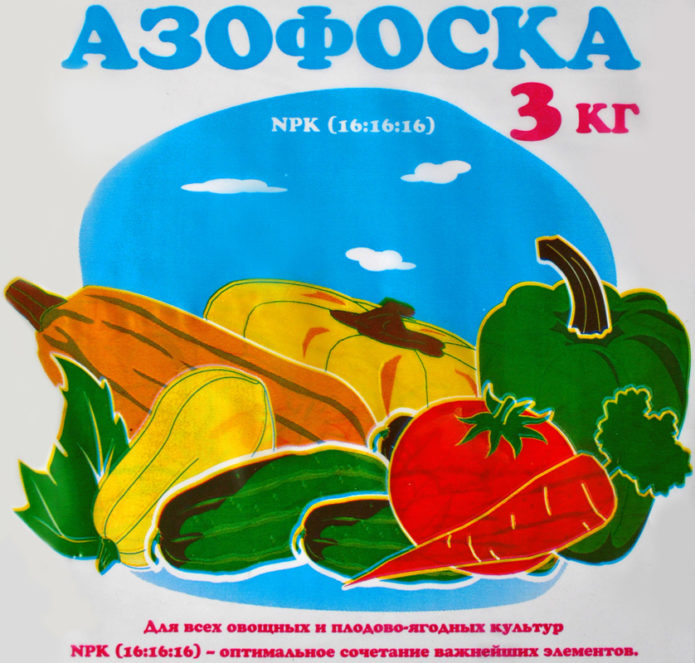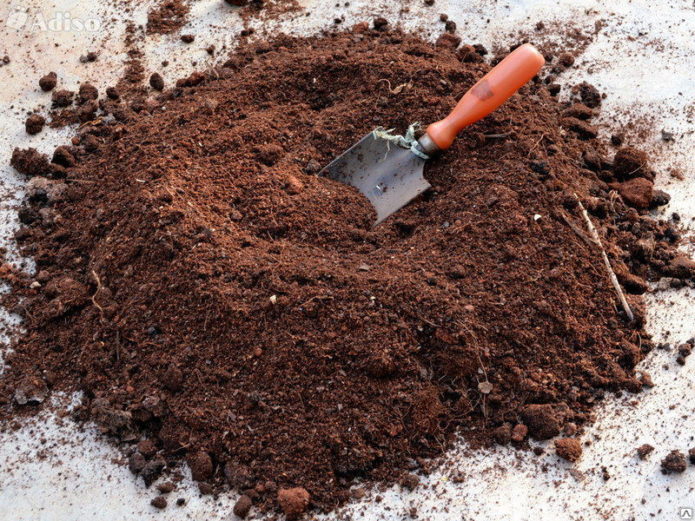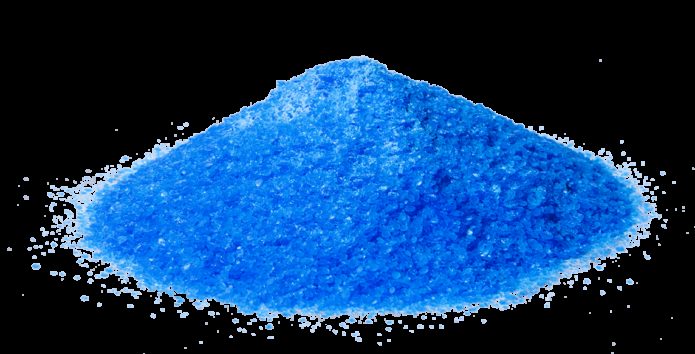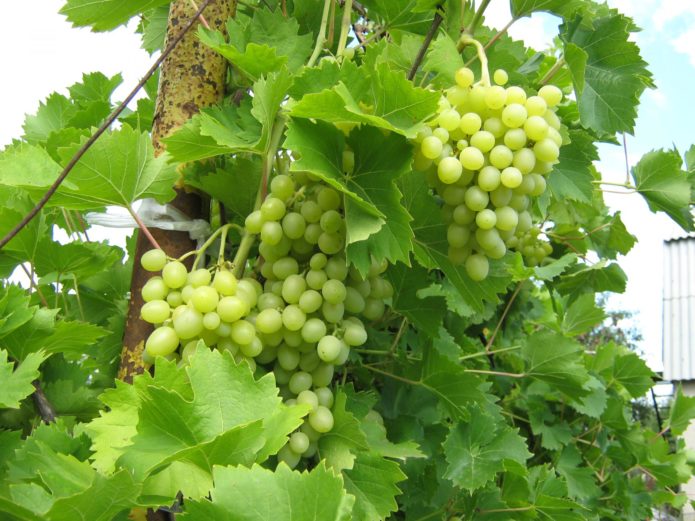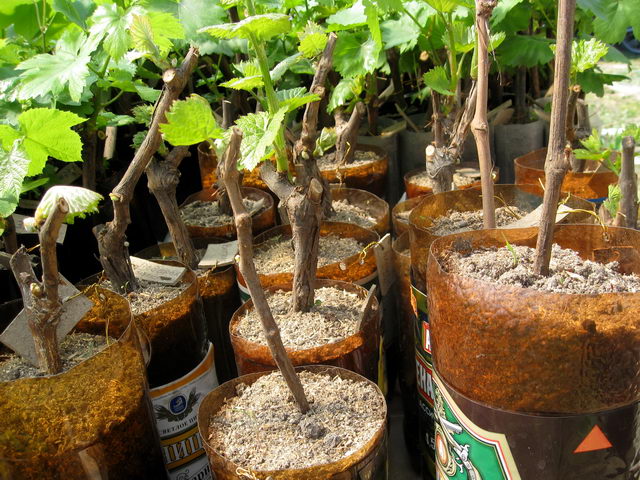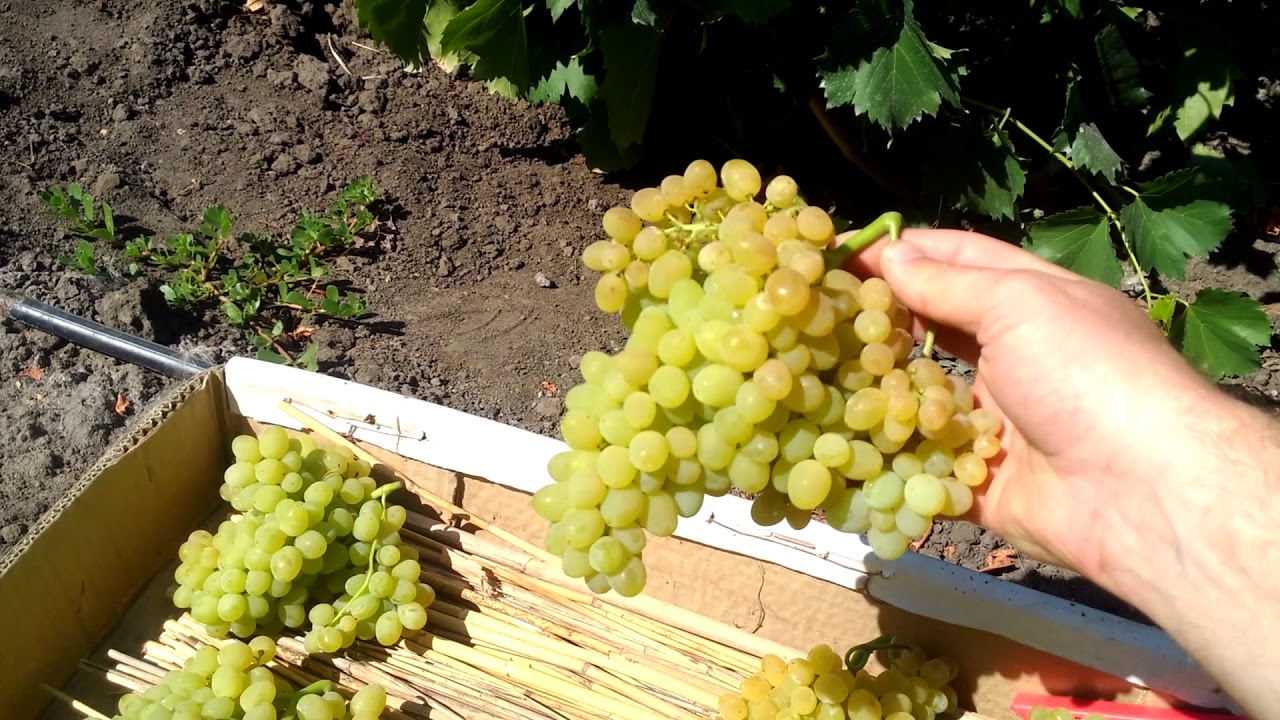Gone are the days when grapes were considered a southern berry: now, in the summer cottages of most regions of the country, you can often find several bushes of this useful plant. You can get a high yield of grapes only with careful care, one of the components of which is the mandatory application of fertilizers. And then success is assured: the most delicious appetizing bunches will not be translated on your table!
Content
The value of fertilizers in the cultivation of grapes and their types
Grapes are a perennial crop, therefore, when applying fertilizers, it should be borne in mind that they will work for the next year. In addition, one must take into account the effect of fertilizers applied before planting or in the previous year.
In the first years of life, grapes require more phosphorus nutrition than others, which stimulates root growth. Nitrogen fertilizers are required from the second and third year, especially with good growth. Grapes have been growing in one place for many years, so it is difficult to apply fertilizers close to the roots without damaging them. This explains the use of abundant pre-plant fertilization with manure (humus), phosphorus and potassium. Manure provides the grape bush with food for several years. Mineral nitrogen fertilizers are applied every year.
Consider the various fertilizers used in home garden viticulture.
Nitrogen fertilizers for grapes
Ammonium nitrate (ammonium nitrate) is a universal nitrogen fertilizer. Strongly hygroscopic, that is, it quickly absorbs moisture and cakes. Acidifies the soil, requires to neutralize it with slaked lime. The most convenient form is in granules.
Ammonium sulfate contains less hygroscopic. It acts more efficiently on neutral soils than on acidic ones, as it has a pronounced acidity. Soil consistency should be reduced by liming.
Ammonium chloride contains 24-25% nitrogen. Should be applied on limed soils or together with alkaline types of phosphorus fertilizers.
Sodium (Chilean) nitrate (sodium nitrate) is also hygroscopic and cakes. Slightly alkalizes the soil.
Urea (urea) is deservedly considered one of the safest and most concentrated nitrogen fertilizers. Excellent water-soluble. In fine-crystalline form, it weakly cakes and after long-term storage does not dissipate well. Granular urea does not cake and disperses well. To eliminate the acidifying effect on the soil, 800 g of chalk should be added to 1 kg of urea. It is most suitable for foliar fertilization with nitrogen by spraying with 0.5-1% aqueous solutions.
Potash fertilizers for grapes
Potassium chloride contains 52-60% potassium oxide. In a humid room, it cakes heavily. Used everywhere. It is good to pre-lime acidic soils or add lime to the fertilizer. Compatible with any fertilizers, except urea, but when preparing mixtures, they must be thoroughly mixed.
Silvinite contains 12-18% potassium oxide, potassium-magnesium sulfate up to 28%.
Potassium monophosphate is a double fertilizer containing, in addition to potassium, and phosphorus. By its chemical nature, it is potassium dihydrogen phosphate. Very good water solubility. Appearance - colorless crystals. Since it contains impurities, it is usually light brownish granules.
When they say that monophosphate is one of the best double fertilizers, they are a little cunning. In terms of potassium content, chloride, sulfate and nitrate surpass it; phosphorus - superphosphate, especially double. Not the best choice for grapes. Usually, in the second half of summer, it is fed with potassium magnesium (potassium-magnesium fertilizer), in which potassium and magnesium are in an optimal ratio. But if the year was wet, the vines may lack potassium, and there may be few berries the next year. In this case, for the winter, you can feed the grapes and monophosphate.
Phosphate fertilizers for grapes
Superphosphate (powder) contains up to 19.5% phosphorus oxide. Suitable for use everywhere, but strongly acidic soils should be limed, or superphosphate should be mixed with chalk, limestone, and other slightly alkaline natural materials with humus before application. On other soils, it can be used with any fertilizer. At high humidity, it cakes, dispersibility increases with the addition of chalk or limestone. Superphosphate contains gypsum, which is useful for most horticultural crops. The granular version cakes less. It is used everywhere.
Double superphosphate is a more valuable fertilizer, without gypsum, contains up to 48% phosphorus oxide.
Phosphorite flour contains 14–23% phosphorus oxide. It is required to make more than superphosphate. Effective and long-lasting only on acidic soils.
The precipitate, in comparison with the other named drugs, is much better soluble. Reduces the acidity of the soil somewhat. Compatible with all other fertilizers.
Complex and complex fertilizers for grapes
Complex fertilizers are divided into complex, mixed and complex-mixed. The difference between these terms for a gardener and a winegrower is insignificant: the point is only in the ways of making complex fertilizers. This can be a chemical reaction of the starting components or simple mixing of conventional fertilizers.
Azofoska (nitroammofoska)
Azofoska (formerly called nitroammophoska) is one of the most balanced complex fertilizers in terms of three main elements. Azofoska is used for feeding grapes in any form. In dry form, it is scattered under the bushes (up to 60 g per bush), in liquid form, it is watered under the root with a solution containing 2 tablespoons of fertilizer per bucket of water. Dry use is possible only with the onset of heat.
Nitrophoska
Nitrofoska is a classic mineral fertilizer. Nitrophoska contains nitrogen (16%), phosphorus (16%) and potassium (16%). The difference from azophoska is small: there is no ammonium nitrogen in the composition. In addition, various essential trace elements are present as impurities. The use is universal. Compared to Azofoska, the application rates for grapes can hardly be adjusted.
Florovit
Florovit is a complete complex fertilizer, used in viticulture in all situations, “works” throughout the summer. Nitrate-free preparation. Before planting grapes, add up to 150 g of florovit per 1 m2... As top dressing - from 40 to 60 g per bush.
Bishal
Bishal is practically a well-known bischofite, which is used in medicine and is a solution of salts of underground seas. Thus, in essence, it is an environmentally friendly drug. Contains many components, including magnesium, boron, molybdenum, iodine, bromine, etc., more than 10 trace elements of natural origin, but most of all magnesium. It is used in viticulture for foliar feeding. It is recommended to take 150 ml of the preparation per 10 liters of water for processing on green leaves, however, experienced growers advise to reduce the concentration by half.
Novofert
Novofert (produced in Ukraine) is a water-soluble fertilizer, contains all macroelements, as well as trace elements in a form bound in strong complexes with Trilon B. The exception is non-complexing elements: boron and molybdenum, which are present in their usual form. Novofert contributes to the adaptation of grapes to adverse environmental conditions. Let's dissolve well. It can be used almost all summer. Compatible with most insecticides. For feeding grapes in any way (by leaves or at the root), 10 g of the preparation is dissolved in a bucket of water.
Helatin
Helatin (Ukraine) is a complex water-soluble fertilizer containing a complex of trace elements in an easily digestible form, optimized for the development of the vineyard. Recommended for spraying bushes from the very beginning of the growing season. "Ambulance" in the following situations: drying of leaves from the edges, the appearance of pale or brown spots, yellowing and death of leaves, shedding of berries. For spraying leaves on 10 liters of water, use 25 ml of the drug.
Nutrivant plus
The fertilizer is made on the basis of highly soluble potassium monophosphate; an adhesive is also added to the composition, which improves adhesion to the leaves. Therefore, the fertilizer has a long-term effect (up to 20 days), it is not washed off by rains. Foliar dressing with Nutrivant Plus fertilizer is a good way to provide the vineyard with basic nutrients. Application of Nutrivant Plus in early spring stimulates root growth. The concentration of the spray solution is 1%. Top dressing is carried out three times: in the budding phase, when berries grow to the size of a currant, and two weeks after re-processing.
Agro-Nova
Fertilizer "Agro-Nova" all the elements necessary for plants, bound in complex compounds by Trilon B, and growth stimulants. Well water soluble fertilizer, suitable for drip irrigation systems. The ratio of the components promotes good assimilation by the bush, stimulates flowering and fruiting, leads to the production of large berries, and improves their taste. Increases resistance to spring frosts and dry summers, as well as to diseases. In the spring, it is recommended to water the bushes with a solution containing 90 g of the drug per bucket of water. For spraying, you need a solution containing 10 g of fertilizer per bucket of water. Top dressing is carried out in the morning or in the evening throughout the summer 1-2 times a month.
Bioton
Bioton is an organic fertilizer. It is made on the basis of poultry manure and peat, without chemical additives. Does not contain pathogens and weed seeds, meets all hygiene requirements. Used in different situations. When planting, apply up to 1 kg of fertilizer per 1 m2, for root dressing, 200 g of the drug is infused in 10 liters of water. Consume 5 l per 1 m2.
Organic fertilizers
Manure is the most important organic fertilizer. A versatile food for most horticultural crops. However, it must be properly stored and used. The best option is a tight or so-called cold storage option. When applied, the least amount of nutrients is lost. As a result of six-month storage, semi-rotted manure is obtained, which, per ton, contains 30-60 kg of nitrogen, phosphorus and potassium oxides. The best manure among the actually used considered horse.
Manure must be used for planting.Mineral fertilizers are often added to it (except for nitrogen fertilizers: this does not make economic sense, there is enough nitrogen in manure, but this element does not persist for a long time in the soil).
Poultry manure is a powerful, fast-acting fertilizer. More concentrated fertilizer than mammalian manure; present in the droppings and quite a lot of magnesium oxide, as well as the sulfur necessary for most plants.
Peat is widely used as a local fertilizer, readily available in a number of regions. It is used for bedding livestock, after which it becomes part of the manure. It is used both in the preparation of composts and as an independent fertilizer. In vineyards, they are often mulched with soil around the bushes.
Peat intended for use without composting must be highly decomposed. To remove excess moisture and oxidize harmful substances, it must be ventilated for several days. It is usually used in very high doses - over 50 tons per hectare.
Compost is a decomposed mixture of various organic waste mixed with soil or peat. Contains up to 0.8% nitrogen, up to 3% phosphorus oxide and up to 2% potassium oxide. Waste can be garbage, weeds, fallen leaves, excrement, etc. Simultaneously with the waste, lime, ash and other materials that increase alkalinity are introduced into the compost. You can also add a little slurry to speed up waste decomposition.
The pile of compost is kept moist, periodically shoveling. It ripens from several months to a year, depending on the composition, weather and care of the heap. The nutritional properties of properly prepared compost are no worse than those of manure.
Folk remedies for fertilizing grapes
Ash is a valuable potassium-phosphorus fertilizer containing some trace elements. It is used as a mineral fertilizer, often mixed with superphosphate. Ash is primarily a supplier of potassium and calcium. Ash is especially good on acidic soils.
Grapes consume a lot of potassium, and ash (stove or from a fire) as its source for grapes is very important. Ash is constantly sprinkled on the ground around the bushes, the leaves are sprayed with ash infusion. In autumn, grape bushes are watered with ash infusion, and in spring, ash is buried next to the bushes.
The author of these lines does not throw away the eggshells throughout the winter, putting them in a bag on the balcony. Does this make economic sense? Hardly, but this habit is strong. Indeed, the shell contains elements important for garden plants, including the vineyard. Of course, you cannot accumulate all the necessary volume over the winter, but still ... The shell of chicken eggs contains up to 95% calcium, it contains potassium, magnesium, phosphorus. These elements dissolve easily in the soil and are absorbed by the roots of the grapes.
Eggshells increase soil fertility and alkalinize it. However, it is better to use the shells of raw eggs: some properties are lost during cooking. The shell must be greatly crushed, after having washed it out with running water. After washing, dry in the sun or in the oven.
Yeast regulates the state of microflora in the soil. They are used as dressings. Baker's yeast is the best. The classic recipe for making a top dressing from yeast is as follows. Live yeast is stirred in a bucket of warm water and left overnight (100 g of yeast is diluted in a bucket of water). Up to 2 liters of nutrient mixture is poured under the root of one grape bush.
Microfertilizers for grapes
Microelements are such chemical elements that plants need significantly less than basic ones (potassium, phosphorus, nitrogen), but without which they cannot fully develop. The most important trace elements are manganese, magnesium, molybdenum, boron, copper, sulfur, zinc, iodine, etc.
All of these elements are included in numerous preparations produced by the chemical industry. The number of such drugs is growing steadily, and it is unrealistic to give a detailed overview of all those on the market. However, some of them have been known for a long time and have earned indisputable authority.
The classification of micronutrient fertilizers by type exists according to the nature of the basic substance. However, there are many complex micronutrients containing several micronutrients. This approach saves the summer resident from the need to select components by hand and weigh them in very small quantities: often the household does not even have suitable scales. Below are some examples of micronutrient fertilizers.
For example, potassium magnesium contains up to 28% potassium and up to 18% magnesium. It is usually used as a top dressing in the form of a solution containing 1 tablespoon of the drug per bucket of water. Both elements are contained in it in the form of sulfates, that is, they also contain the third important component needed by the vineyard - sulfur (about 16%).
Copper sulphate is used for spraying on the leaves, since the drug is perfectly soluble in water. Vitriol is introduced once every 3-5 years, about 1 g for each grape bush.
Boric acid and borax contain 37 and 11% boron, respectively. Used for spraying in early summer. Dosage of drugs: only 0.1–0.2 g per bucket of water.
Ammonium molybdate: it contains up to 52% of the active ingredient - molybdenum. You could bury it in the soil, but you have to scatter one pinch over several meters, which is not easy. Therefore, it is most often used in solutions. Its concentration for dressing is very small: 0.01-0.05%, therefore, in summer cottages, they often do not take up the use of molybdate itself, as in fact, most other trace elements, but buy ready-made mixtures of drugs: in such cases, you no longer have to look for backrooms microbalances!
Traditional zinc microfertilizer - zinc sulfate (up to 25% Zn), is especially effective on alkaline soils. Dosage in top dressing: about 5 g of zinc sulfate per bucket of water.
Among the many modern micronutrient fertilizers, capsule preparations of prolonged action are very convenient. Nutrient components are enclosed in granules covered with a low-permeability shell, so their consumption by plants occurs gradually, stretched out over time. The capsule contains all the necessary macro- and microelements in an optimal ratio. After being introduced into the soil, moisture, getting into the capsule, slowly extracts micronutrient fertilizers from it, so their duration is from several months to 3 years. Examples of such products are Osmokot, Multicot, Activin, Trainer.
Fertilization calendar
Fertilizers in vineyards are used all the time of their growth and fruiting. At the same time, various dressings do not replace the fertilizer introduced into the planting pit, and even the annual autumn or early spring fertilization, but only supplement them. Top dressing is done as needed and should not become an end in itself.
Fertilization stages
There are several stages in the use of fertilizers in the vineyard:
- Pre-planting fertilization, that is, the introduction of a large dose of fertilizer into the planting pit during its preparation. They provide the plant with food for many years.
- Basic dressing. They represent an autumn or early spring embedding of fertilizers into deep holes (up to half a meter), dug out next to the bushes. In autumn, organic fertilizers (manure, compost, peat) are used, to which you can add superphosphate and ash. In spring, a variety of fertilizers are used, including nitrogen ones.
- Additional dressing carried out at various times throughout the summer.This can be both liquid root dressing, that is, the application of fertilizers in the form of solutions in pits or trenches near the bush, and foliar dressing, performed by spraying grape bushes with nutritious leaves.
The composition of dressings strongly depends on the season and on the condition of the grape bush. But grapes are very fond of potassium, so potash fertilizers can be used in the maximum possible dose, and ashes - almost as much as there is. The so-called green dressings are also used in the vineyards. For this, peas, vetch, lupine or oats are sown next to the bushes, which are dug up, not allowing seeds to form.
It should be remembered that feeding is carried out at the required rate: it is better to under-feed than to overdo it! They are needed when the bushes are really starving. We don't need extra "chemistry" on our site! Sometimes foliar dressing is combined with the treatment of bushes with Bordeaux liquid to combat grape diseases. The simplest option, combining top dressing with prevention, is to use ordinary ash, which is infused in water for a day (a handful of ash in a bucket of water). After that, the infusion is filtered so that the sprayer nozzle does not clog.
Life story. About 20 years ago, the author of these lines first planted grapes in the country. After reading somewhere that the landing pit should be at least one and a half meters deep, he dug it all day, fighting with heavy clay. The neighbors laughed, but ... Fertilizers introduced into the pit during planting (and it was mainly manure, but in fair quantities) still allow the Arcadia grapes to exist well. I confess that I hardly fertilize the grapes on purpose, it is enough for him that he "steals" from vegetables in the neighboring beds.
The algorithm for fertilizing and feeding grapes is well demonstrated in the next video.
Video: methods of fertilizing grapes
Approximate fertilization plan by month
Taking into account the properties of various fertilizers, the state of the grape bush and being guided by the principle of "do no harm", you can draw up an approximate work plan for months, which will certainly be adjusted depending on the weather, the state of the vine and leaves and, of course, the region:
- April. Fertilizers applied during planting slowly begin to dry out after a few years. Starting from 3-4 years, in early spring, they dig holes up to 40 cm deep next to the bushes and apply organic and mineral fertilizers to them, filling them with soil. The dosage is approximately as follows: a bucket of rotted manure, 20-30 g of nitrogen fertilizers and 10-15 g of superphosphate for each bush. As for potassium, this is a separate topic. The need for potassium in grapes is especially high until about July, and then decreases slightly. But the vineyard loves this element very much! Therefore, in addition to introducing 10-15 g of potash fertilizer into the hole, you can add 3-4 handfuls of wood ash.
- May. Two to three weeks before flowering (that is, at the end of the month), liquid root dressing is performed. For its preparation, dissolve in 10 liters of water 10-15 g of urea, 15-20 g of superforsphate and 5 g of any potassium fertilizer. A bucket of solution is spent on one bush, pouring it into shallow grooves dug around the bush. Of course, mineral fertilizers can be replaced with bird droppings or slurry, diluting them well in water and letting them wander. For example, chicken manure should be taken 0.5 kg and diluted in a bucket of water, held for at least 12 hours, and then diluted 10 times more. And now pour the diluted solution under the bush about a bucket.
- June. The first foliar dressing is performed a week before the flowers bloom. For it, aqueous solutions of complex fertilizers (for example, azofoska) are used. Azofoska is dissolved in a dose of 2 teaspoons per bucket of water and the leaves are abundantly sprayed. In order not to burn them, the procedure is carried out in the evening hours, preferably on non-sunny days. After the end of flowering, you can repeat the foliar dressing with the same formulations.At the end of June, you can feed the bushes with infusions of organic fertilizers (bird droppings, mullein), as in May.
- July. The following dressings are performed with the beginning of the ripening of the berries. The concentration of solutions must be created strictly according to the instructions attached to the drug. At this time, you need to use preparations containing all the basic nutrients. For speed of impact, it is best to do foliar feeding: in the middle of summer, the leaf apparatus in the vineyard is actively working. The easiest way at this time to use purchased drugs: "Novofert" or "Master". One should not forget about feeding young seedlings that have recently been planted in the vineyard.
- August. Top dressing of bushes at the beginning of ripening of berries and young seedlings with phosphorus-potassium fertilizers (always excluding nitrogen!). The fact is that plants always need nitrogen, including when berries ripen. However, you always have to make some kind of compromise, since overfeeding with nitrogen in the second half of summer can lead to a powerful regrowth of the vine, which will not ripen by winter, which means it will die. And if overfeeding with nitrogen threatens the non-ripening of branches even for familiar trees (apple, pear), then the southern culture - grapes - this applies to an even greater extent. If it is noticeable that the vineyard does not have enough water, watering is carried out, at the same time adding phosphorus-potassium fertilizers to the water (1-2 tablespoons per bucket of water). If watering is not required, you can irrigate the leaves, taking not tablespoons, but teaspoons of fertilizers. But from the middle of the month, you should not water the bushes. If the vine does not ripen well, is still green, and even grows, foliar fertilizing with potassium monophosphate is carried out on the upper leaves.
- September. Foliar dressing of the bushes with phosphorus and potash fertilizers is repeated. They are performed in the same way as in August.
- October or November. Before covering the bushes for the winter, you can carry out the main fertilization, if it is more convenient for you to do this in the fall than in the spring. But the later this happens, the better.
Top dressing when growing planting material
Separately, it should be said about the use of fertilizers in the process of growing planting material from cuttings (shanks). Chubuk is a section of a vine with 3-4 well-developed buds. In areas with a mild climate, cuttings are planted directly in the ground since autumn; in the middle lane, this is done at home in pots from about the end of February.
Cuttings also need nutrition and constant loosening. The main fertilization almost does not differ from that in the case of planting bushes for many years, except that organic matter can be taken less. When preparing the soil at the site, they dig up the earth to the depth of a shovel bayonet and add sand, as well as 100 g of azophoska, and 1-2 buckets of humus per 1 m2... After that, they dig it up again, distributing fertilizers well in the soil.
At home, at the end of winter, the soil is prepared in the same way or bought in the store, filling its cups at least 25 cm high.
With a poor soil composition and high acidity, cuttings may grow poorly and try to dry out. In this case, a simple accessible remedy often helps: wood ash. Insist 2-3 tablespoons in 1 liter of water and well watered containers with cuttings, on which by this time the leaves are already growing. Ash can also be added for prophylaxis, when planting cuttings. After a couple of weeks, the operation can be repeated.
So, going to the store for summer residents, you saw entire shelves of preparations for protecting the vineyard and for feeding it. Do I need to grab onto these pretty bags? Of course, you should first read about them carefully and give yourself time to think. Of course, one cannot do without mineral fertilizers, but usually they can be replaced with more ecological fertilizers. After all, we do not need forty buckets of grapes at the dacha, right?


